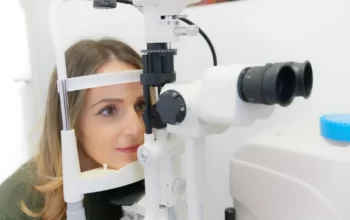
Despite their similarities, astigmatism and myopia—commonly referred to as short-sightedness—are two distinct conditions that result in refractive errors that impair vision. Your visual acuity is affected by both refractive errors, but myopia blurs distant objects while astigmatism distorts images at all distances. The distinctions between myopia and astigmatism can also be seen in a variety of factors, such as causes and symptoms.
Let’s learn how to comprehend these two types of refractive error, which are essential for spotting them in time to protect your eyes’ health.
What Is Astigmatism?
Because it can affect both near and far vision, astigmatism is a special type of refractive error. When the cornea or lens have an irregular or cylindrical shape, the eye condition occurs.
Because perfectly round eyes are rare, many people have mild astigmatism. You might never notice the condition if it’s mild. People with eyes that are moderately to severely astigmatic, however, are more likely to experience symptoms and need vision support techniques.
Symptoms of astigmatism include blurry vision in the distance or up close, as well as:
- Headaches
- Eyestrain
- Eye irritation
- Difficulty with night vision
- Squinting (to focus vision)
What Is Myopia?
Short-sightedness, also known as myopia, impairs a person’s ability to see distant objects. It happens when the eye grows too long, allowing light to miss the retina. When viewing distant objects, this causes blurred vision.
Myopia can manifest in a variety of ways, including the following:
- Blurred vision or overcast of objects at long distance
- Headaches
- Squinting to concentrate on far off objects
Myopia VS. Astigmatism
Myopia and astigmatism are both refractive errors, so they share many characteristics. Although both can impair distance vision, the conditions are different vision issues. Here is a comparison of the contrasts.
Vision Problems
Astigmatism can also result in blurry near vision, though both refraction errors can blur vision at a distance.
Other ocular conditions, such as retinal issues that affect central vision, can arise as a result of degenerative myopia.
Shape
When the lens or front surface of your eye is distorted or cylindrical, astigmatism results. When the cornea is too steeply curved or the entire eyeball is too long, myopia results.
Rarity
Of all refractive errors, astigmatism is the most prevalent. However, astigmatism frequently manifests in a mild form that may not cause symptoms.
Myopia can be mild, but it can also progress (degenerative myopia), and it is becoming more common. Myopia now causes vision changes that start earlier in childhood and last longer into adulthood.
Severity
Depending on how severe or minor the condition is, astigmatism and myopia can have varying effects on a person. High myopia, however, can pose more serious risks to eye and vision health.

What Difference Do Astigmatism And Myopia Have?
Myopia typically develops in school-age children, whereas astigmatism typically occurs from birth. In most cases, myopia will worsen until it stabilizes in early adulthood. Myopia is closely related to genetics and environmental factors, whereas astigmatism typically results from the natural shape of your eyes. For instance, a child is more likely to be myopic if one or both parents are. Myopia, however, can also develop if the eyes become a little too long.
Astigmatism and myopia frequently coexist, making the likelihood that you are also short-sighted higher if you have astigmatism. Long-sightedness, or hypermetropia, is another association. Both refractive errors influence how light enters your eyes in this way.
Myopia and astigmatism both cause blurry or distorted vision, which is one of the symptoms of both conditions. However, myopia causes distant objects to appear blurry, and astigmatism also makes it more challenging to distinguish between different shapes. If you don’t get treatment in either situation, you might get headaches or eye strain.
Are There Treatments For Myopia Or Astigmatism?
Typically, corrective lenses can be used to treat both refractive errors, which are identified during a routine eye exam. But contact lenses are the only option for treating astigmatism that is irregular.
Through orthokeratological lenses, which help to improve the curvature of the eye while you sleep, it is possible to slow down the progression of myopia. This implies that you might not need to wear corrective lenses all day.
Treatment For Myopia And Astigmatism
Although there is a clear distinction between myopia and astigmatism, both errors have similar options for treatment and correction:
Glasses, Spectacles And Contact Lenses
The key difference between myopia and astigmatism is exceptionally favorable: both conditions can be rectified. Using glasses or lenses that enable the person to focus on any picture regardless of distance appropriately is the most widely accepted strategy for treating the symptoms of these conditions.
To use this traditional method, it is necessary to know how many diopters a person has or needs in order to create customized lenses that correct the flaw and allow light to frame on the retina.
Orthokeratology (ortho-k) employs yet another variety of corrective lenses for myopia correction. This kind of rigid contact lens is used to reshape the cornea and is typically worn at night while sleeping.
Lasik Medical Procedure
Not everyone needs to wear glasses or contacts, but some people want to decide on a formal remedy. In these situations, laser-assisted in situ keratomileusis, or LASIK, is recommended as a refractive surgery option. To use the same laser technology and correct the deformity that is causing myopia, astigmatism, or possibly both, this laser surgery involves lifting the cornea. Before deciding whether to have LASIK, it is advisable to learn more about the possible side effects of the procedure.
Conclusion
It can be difficult to comprehend the similarities and differences between refractive errors without professional assistance. Contact our staff at IndividualEyes if you’re noticing symptoms or changes in your vision. After getting to know you, we can recommend options to manage your visual comfort. We can assess your eye health to understand your vision better. To find out more about your distinctive eyes, schedule a consultation.



